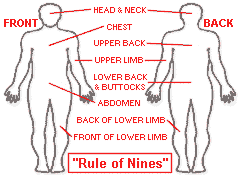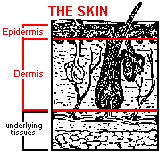Burn injuries are classified by: The Extent of the injury, The Depth of the injury, and The Cause of the burn.
The Extent of the injury
 There
are different ways to calculate the extent or size of a burn injury, but
the most usual way used to quickly get an idea of burn size is the "Rule
of Nines", where the body is divided into eleven areas each of which
represents 9% of an adult's total body surface area. These eleven areas
are: the head and neck, the chest, the upper back, each upper limb (arm
and hand), the lower back and buttocks, the abdomen, the back of each
lower limb (leg and foot), and the front of each lower limb. This adds up
to 99%. For children, whose heads make up more and whose legs make up less
of their total body surface area, the front and the back of the head are
each counted as one 9% area, and the front and the back of each lower limb
is counted as 6¾%. First-degree burns are not included in
calculations for burn size.
There
are different ways to calculate the extent or size of a burn injury, but
the most usual way used to quickly get an idea of burn size is the "Rule
of Nines", where the body is divided into eleven areas each of which
represents 9% of an adult's total body surface area. These eleven areas
are: the head and neck, the chest, the upper back, each upper limb (arm
and hand), the lower back and buttocks, the abdomen, the back of each
lower limb (leg and foot), and the front of each lower limb. This adds up
to 99%. For children, whose heads make up more and whose legs make up less
of their total body surface area, the front and the back of the head are
each counted as one 9% area, and the front and the back of each lower limb
is counted as 6¾%. First-degree burns are not included in
calculations for burn size.
The Depth of the injury
 The
depth of a burn injury is usually classified in one of two ways. The first
way is First-, Second-, or Third- degree, and the second way is Partial
thickness or Full thickness.
The
depth of a burn injury is usually classified in one of two ways. The first
way is First-, Second-, or Third- degree, and the second way is Partial
thickness or Full thickness.
First-degree burns
damage only the epidermis (the outer layer of the skin.) A first-degree burn is usually red in colour, and can be very painful. There are usually no blisters, and the burn will heal on its own without scarring in a week or less.
Second-degree burns
damage the epidermis and the dermis (the layer beneath it). When treated with reasonable care, second degree burns will heal themselves. These burns are also sub-classified as either Superficial or Deep.
Superficial
second-degree burns damage only the outermost part of the dermis and are extremely painful and very sensitive to touch. The skin looks moist and mottled pink or red and blanches (turns white) if you press on it. There are usually blisters. These burns usually heal within three weeks, and leave very little scarring.
Deep
second-degree burns destroy the deeper layers of the dermis, and usually need skin grafting. These burns are dry and whitish in appearance, and usually painful. The skin does not blanch if you press on it. Healing takes up to four weeks and may leave hypertrophic scars.
Third-degree burns
damage or completely destroy all the layers of the skin, and may also damage parts of the body underneath the skin, such as muscles. They are the worst of all burns, and need skin grafting unless they are very small. The burned skin is charred and leathery and often sunken in from the area around it. These burns usually are not painful, because the nerve endings have been destroyed. As third degree burns heal, dense scars form. Very deep third-degree burns are sometimes called 4th-degree burns.
Partial thickness burns
are ones which will heal by themselves: either First-degree or Superficial Second-degree.
Full thickness burns
are ones which, unless they are very small, will need skin grafting. Deep Second-degree burns and Third-degree burns are full thickness burns.
The Cause of the burn
Chemical Burns:
When the skin comes in contact with strong acids, alkalis, or other corrosive materials, there is a chemical reaction which gives off heat. This heat causes burning, which usually continues as long as the chemical stays in contact with the skin.
Electrical Burns:
When an electric current travels through the body, the electrical energy is changed to heat, which causes a lot of damage. The heat normally follows the current flow, which is usually along blood vessels and nerves, but it may also damage other things, like muscles and bones.
Radiation Burns:
A radiation burn is caused by exposure to ionizing radiation. (The main kinds of ionizing radiation are alpha particles, beta particles, gamma rays, x-rays, and high-energy ultraviolet radiation.) Sunburn, which is caused by ultraviolet radiation, is the most common kind of radiation burn.
Thermal Burns:
A thermal burn is caused by exposure to heat. Most thermal burns are caused in one of these ways:
Contact burns
are caused by touching something hot. They can vary in depth. Usually, a person's reflexes protect them from prolonged contact with the hot object, but prolonged contact can cause full-thickness burns.
Flame burns
are often deep burns, especially when caused by a person's clothing being set on fire. Flame burns usually cause deep partial-thickness to full-thickness burns.
Flash burns
are caused by explosions such as those from petrol (gasoline) or gas, and also by electric arc flashes and blasts. They vary in depth depending on the intensity of the flash and how close to it a person is. Flash burns involve parts of the skin not covered by clothing, such as the face and hands.
Scalds
are burns caused by hot liquids. They are usually not as deep as flame burns, but can produce deep burns. Hot water or coffee usually cause deep partial-thickness burns. Hot grease or soup can cause full-thickness burns.

 Click/tap here to go back to the main "FACTS and FIGURES" page
Click/tap here to go back to the main "FACTS and FIGURES" page